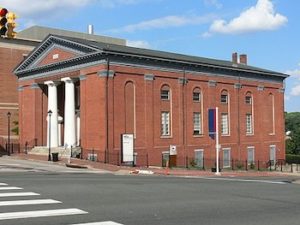
*The First African Baptist Church, a prominent black church in Richmond, Virginia, began services on this date in 1841.
The First African Baptist Church was founded by Black members of Richmond's First Baptist Church. The First Baptist Church housed a multiracial congregation from its beginning in 1802 until the white members built a new church in 1841. In the years leading up to the split, whites were a minority at the church, which made some of them uncomfortable. Many Black members had also called for a split due to the lack of admission after the building became crowded.
After they had built a new church building for the white members of the First Baptist Church, the church leadership sold the building where they had held meetings to the black members. They added "African" to the title. Initially, it was founded by members of both slaves and freedmen. Most of its early slave members were initially from the Tidewater region of Virginia, located near Richmond. Many freedmen traveled from other cities to attend its services, as well. Approximately 1,300 Black members were present when the congregation split from the First Baptist Church. It soon experienced rapid growth, and by 1861, the services held more than three thousand people.
Though it was a Black church, it was led by a white minister and a board of thirty black deacons because it was illegal for blacks to preach. Although most members were slaves in the years preceding the American Civil War, most early leaders were freedmen. The first senior minister, Robert Ryland, served from 1841 until 1865. Ryland owned slaves and believed that slavery was the best way to convert Africans to Christianity. The church also sent several of its members to Africa as missionaries. Virginia state law did not permit slaves to marry, but the church would hold wedding ceremonies for its members. The church allowed slaves to divorce and remarry if they were sold out of state. Some white residents of Richmond frequently cited the positive tone of services there as proof that their slaves lived happy lives, much to the dismay of their slaves.
Even though it was against state law to teach Blacks to read, Ryland published a catechism for members, allowing them to learn to read. This practice caused some controversy, but Ryland defended himself by citing that his lessons emphasized submission to authority. His practice of educating slaves was initially controversial due to a high-profile murder committed by a member of the congregation. Richmond's white churches eventually defused the situation by supporting Ryland's educational programs. Ryland later touted the conservatism of his congregation against those who feared slave rebellions. Some members preached from the pews, and others were purchased from their owners and emancipated with funds raised by the church.
While the Confederate States of America government was in Richmond during the war, the church held speeches by politicians, including Governor William Smith and President Jefferson Davis. Judah Benjamin also spoke at the church to recruit blacks into the Confederate Army. In 1865, Horace Greeley, abolitionist publisher of the New York Tribune, said at the church regarding the post-Civil War Reconstruction. It did not gain its first Black senior minister until 1867, however.
The first Black man to serve as senior minister was James Holmes, a longtime deacon born a slave. The number of members swelled to 4,500 by 1869. Under Holmes, the church became one of the largest churches in the country. In 1871, he baptized 600 people; in 1878, he baptized 1,100. In 1876, the original building was torn down. The congregation built a new church costing $35,000 and installed an organ, the largest in any African American church, for $2,500, in 1877. The original church building and its replacement are at the corner of College Street and East Broad Street. The demolition of the original church building was an act that brought accusations of "a true lack of American veneration for old things" from Harpers Weekly.
Architect Thomas U. Walter designed the new building in the style of a Greek Doric temple. As one of the largest meeting halls in Richmond, it was often rented for white events. Its large interior and prominent location in Richmond made it a sought-after venue for concerts and political rallies. The practice of renting the church was controversial among members due to the use of the church for secular events and the racial segregation often imposed at the events. There was a space located near the pulpit for white visitors. However, the practice continued, in part, due to the increased income.
A dispute in 1880 led to over seven hundred members leaving the church. Their enthusiastic services were a popular attraction for visitors to Richmond. The First African Baptist Church congregation moved in 1955. The church building was sold to the Medical College of Virginia. Some church members characterized the sale as insensitive to the church's contribution to Black history. The building now holds offices, classrooms, and laboratories. It has since had a significant influence on the black community of Richmond.